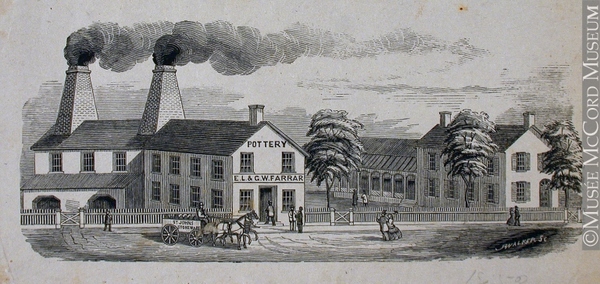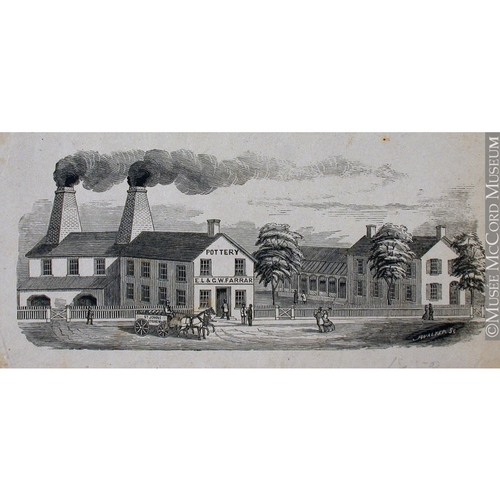
Source: Link
FARRAR, GEORGE WHITEFIELD (Whitfield), potter; b. 29 April 1812 at Fairfax, Vt, son of Isaac Brown Farrar and Alma Lawrence; m. 25 Sept. 1836 Sophia Adams Winslow at Barre, Mass., and they had three sons and one daughter; d. 28 Jan. 1881 at Iberville, Que.
George Whitefield Farrar came of a family whose roots in North America went back to the 17th century, to Jacob Farrar, who emigrated from England to Massachusetts in or about 1653. In the 18th century George’s father settled in Vermont and eventually established a pottery at Fairfax. It was at this pottery that George received his training.
He continued as a potter in Fairfax until the 1850s, when he crossed the Canadian border to Saint-Jean (Saint-Jean-sur-Richelieu). Other members of the extensive Farrar clan had for some years been engaged in potting there and had introduced the making of stoneware to the area. In 1857 he entered into a partnership in Saint-Jean with his potter-brother, Ebenezer Lawrence Farrar. The partnership was announced in the Saint-Jean News and Frontier Advocate as effective from 13 April 1857. It was short-lived, for less than three months later Ebenezer lost his life in the burning of the steamboat Montréal on the St Lawrence. George W. Farrar carried on the business in Saint-Jean, and across the Richelieu River at Iberville after fire destroyed the Saint-Jean plant in 1876. He was joined, when they were old enough, by his sons; the two who had most to do with the pottery were George Henry and Ebenezer Lawrence. At various periods the pottery was officially operated under his sons’ names, but he always maintained an interest in it. After his death it continued in the family name until 1926 when George H. Farrar sold it. The pottery closed in the early 1930s.
The Farrars’ products were the common earthenware and stoneware of the North American potter. Articles produced were almost entirely utilitarian: snuff jars, bottles, spittoons, jugs, teapots, butter pots. Within this range, quality was good. George W. Farrar was awarded a medal for earthenware at the provincial fair in Montreal in 1860; under his sons’ names the factory’s stoneware was exhibited abroad, at Philadelphia (1876) and Paris (1878). In 1861 the pottery used up some 500 tons of clay (stoneware clay was imported from New Jersey) and employed 18 hands. By the 1870s steam power had been installed and 40 persons were on the payroll; the pottery was now one of the largest in Canada.
But George W. Farrar’s accomplishments did not end with the production of dark-bodied earthenware and salt-glazed stoneware. He was the promoter of the St Johns Stone Chinaware Company, the first whiteware pottery in Canada, established in 1873. Because, like most Canadian potters, Farrar never made much money, he lacked capital to embark on such an ambitious venture as the formation of the company on his own, but his was the moving spirit behind it. Much of the required capital came from Edward C. Macdonald, the company’s president and a “merchant prince” of Saint-Jean, who bought the company outright when it slipped into bankruptcy in 1877. Farrar himself was connected with it for only a brief period – he withdrew early to take back the management of his own pottery – yet his had been the vision of a new dimension in Canadian potting: the first commercial production of whiteware.
The News and Frontier Advocate summed up his importance when George W. Farrar, a former councillor of Saint-Jean, died in 1881: “Mr. Farrar encountered many difficulties in this country but he was . . . ever enthusiastic in his schemes. He was undoubtedly the promoter of the St. Johns Chinaware . . . factory, which is at present doing such a large and flourishing business and as he was but a short time connected with the concern, its lack of success at the outset cannot certainly be laid to his charge.”
[Examples of wares from the pottery operated by George Whitefield Farrar and his sons are to be seen in a number of Canadian museums, including the National Museum of Man (Ottawa), the Musée du Québec, the Montreal Museum of Fine Arts, the McCord Museum (Montreal), and the Royal Ontario Museum (Toronto). Farrar family papers are in the possession of Mrs Effie Farrar Sutherland (Montreal). e.c.]
AP, St Johns United Church (Saint-Jean-sur-Richelieu), Register of acts of civil status, I: 197. PAC, RG 31, A1, 1861, 1871 censuses, Saint-Jean, Que. Can., Canadian Commission at the International Exhibition of Philadelphia, 1876, Report (Ottawa, 1877). Montreal Gazette, 5 Oct. 1860, 23 Sept. 1863. Morning Chronicle (Quebec), 4 July 1857. News and Frontier Advocate (Montreal and St Johns [Saint-Jean-sur-Richelieu]), 24 April 1857. Quebec Mercury, 23 July 1857. Canada directory, 1857–58. Eastern Townships gazetteer & directory, for the years 1875–76 . . . (Montreal, 1875). J.-B.-A. Allaire, Histoire de la paroisse de Saint-Denis-sur-Richelieu (Canada) (Saint-Hyacinthe, Qué., 1905). C. H. Chandler and S. F. Lee, The history of New Ipswich, New Hampshire, 1735–1914, with genealogical records of the principal families (Fitchburg, Mass., 1914). Elizabeth Collard, Nineteenth-century pottery and porcelain in Canada (Montreal, 1967). H. H. Lambart, Two centuries of ceramics in the Richelieu valley: a documentary history, ed. Jennifer Arcand (Ottawa, 1970), 5–14. Lura Woodside Watkins, Early New England potters and their wares (Cambridge, Mass., 1950). Donald Webster, Early Canadian pottery (Toronto, 1971).
Cite This Article
Elizabeth Collard, “FARRAR, GEORGE WHITEFIELD (Whitfield),” in Dictionary of Canadian Biography, vol. 11, University of Toronto/Université Laval, 2003–, accessed January 1, 2026, https://www.biographi.ca/en/bio/farrar_george_whitefield_11E.html.
The citation above shows the format for footnotes and endnotes according to the Chicago manual of style (16th edition). Information to be used in other citation formats:
| Permalink: | https://www.biographi.ca/en/bio/farrar_george_whitefield_11E.html |
| Author of Article: | Elizabeth Collard |
| Title of Article: | FARRAR, GEORGE WHITEFIELD (Whitfield) |
| Publication Name: | Dictionary of Canadian Biography, vol. 11 |
| Publisher: | University of Toronto/Université Laval |
| Year of publication: | 1982 |
| Year of revision: | 1982 |
| Access Date: | January 1, 2026 |



